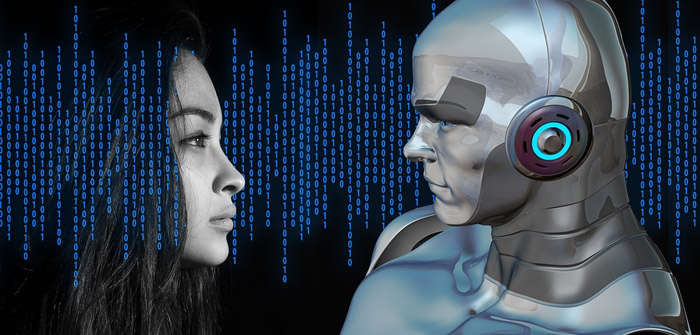(Photo | Pixabay)
In the last column, Artificial Intelligence — Part 2 of 4 — Personal Impact, we briefly covered AI’s impact in our personal lives. In this article, we’ll briefly touch on some of the ways AI is impacting business.
C-Suite Decision Making
Remember Tom Hagen, the Godfather’s Consigliere? He was the advisor whose job it was to whisper wisdom and strategy into the Don’s ear. AI is now the silicon Consigliere to business owners. The business insights and predictive outcomes AI extracts out of billions of data points in seconds provide dynamic business strategies, aka wisdom. Humans are incapable of doing such a feat.
However, the key is not the numbers, but melding the numbers to a myriad of AI learnings from publications, articles, news and other sources to develop informed strategies. A recent Harvard Business Review headline, “Are Metrics Undermining Your Business? — Too Many Leaders Confuse Numbers with Strategies,” hits the nail on the head. AI must be used gather insights, not just metrics.
Employment
Nature of Work — What we do for a living and how we work have been dramatically evolving since the creation of steam-driven cotton mills. Industrial automation drove the first rounds of tectonic change… the industrial revolution. It killed cottage industries and concentrated employment around large, dangerous, repetitious jobs inside giant buildings built for efficiency, not human comfort.
Role Reversal — The next big round is happening now, thanks to artificial intelligence and robotics. Instead of software-driven robots assisting humans, we now see humans assisting AI-driven robots. As we touched on in previous articles, this change is irreversible. Businesses can’t afford to remain on the sidelines as key players replace humans with AI-systems and robotics. The increase in efficiencies, productivity and cost-savings are astounding. A robot works 24/7, does not require breaks, bathrooms, food and drink and parking lots. Once trained, it works with error margins so small it’s effectively zero. It’s never late for work and doesn’t ask for time off. This role reversal requires highly educated and skilled workers to collaborate with AI-driven systems and infrastructure.
White, Blue and No Collars — Any job with defined routines is at risk, from the factory floor to the white-collar-filled skyscrapers. Among the vulnerable jobs are finance, customer service, banking services, retail checkout, process and project management. A recent Brookings Institution report says at least 25 percent of all jobs in the U.S. will be replaced with automation.
Shrinking Workforce — Now for the GOOD NEWS for workers and BAD NEWS for companies: The number of people retiring far outnumbers new people entering the workforce. Our low unemployment rate is not just due to a good economy, it’s also due to the number of people exiting the workforce and declining birth rates in western countries.
Where’s the Migrant Workers — Thanks to a massive shortage of unskilled, minimum wage workers such as migrants, we’ve seen a dramatic increase in automation in agriculture. Dirty jobs such as manure removal in dairy farm operations are now done by robots, like Lely’s Collector robot. It vacuums the stalls around the cattle and disposes it into muck containers. Famwise’s Autonomous Weeding Robots are already in the fields, pulling weeds with very high accuracy thereby eliminating the treating of fields with chemicals. There are fully automated poultry and pork processing facilities with a fraction of the workers used by a traditional plant.
Constant Training — What is required for those currently employed is PERPETUAL TRAINING, regardless of their occupation. AI is creating a vast number of new careers around creating, deploying and maintaining all this new technology. These are high-paying jobs, but our workforce doesn’t have the required skills. If employers won’t step up to bat to train you, then you need to do it yourself. Otherwise, you are at risk. Companies MUST invest heavily in elevating the skills and knowledge of their workforce.
New Job Types — More GOOD NEWS: Humans are the ones training AI systems, creating new disruptive technologies and maintaining/upgrading deployed ones. New jobs include data analysists, data engineers, AI developers, machine learning scientists, algorithm specialists, machine learning engineers and many more. Traditional blue-collar jobs such as vehicle maintenance are already quasi-tech with skills required in computers and diagnostic systems. Companies need to quickly embrace new technology waves and morph their recruiting efforts accordingly.
Hire Creatives — The GREATEST NEWS: What is the human race’s greatest advantage over AI? IMAGINATION. Call it what you like, intuition, inspiration or creativity, the ability to pull an idea from thin air is the one ability we have that artificial intelligence has yet to conquer.
Get Creative — We need to collectively exercise our creative muscles in the arts, philosophy and writing fiction. Schools need to shift to the soft-skill courses of the past, along with hard sciences. I envision a day where such creative endeavors will be more valued than computer science as AI-driven systems write more and more software without human intervention and create algorithms humans have no hope of comprehending. AI will do to software development what calculators did to mental math. Businesses need to move up the food chain and focus on ideation, creativity and invention. To walk my talk, I’m attending Improv classes this month with friends to exercise our creative muscles. Take that, AI.
Manufacturing and Production
Shift to Automation — We’re all aware of automation’s impact on the factory floor, we’ve all seen the transformation over the decades and its effects on jobs. Robotics and AI systems are redefining the term factory. Foxconn, the Taiwanese company that manufactures Apple’s iPhones, replaced 60,000 workers in one factory with automation. Most notably, it plans to replace 80 percent of its workforce in five to ten years, or roughly 500,000 employees. It plans to install one million robots over a three-year period in its China factories.
Robo-Factory — For business, this is good news. New factories will be redesigned to accommodate robotics, not people. Employees typically work horizontally in a manufacturing process (i.e. a factory floor). Robotics are not constrained by such conventions and can make full-use of three-dimensional space. Shorter distances between robotic processes means increased through-put and less real estate to build. In the not-too-distant future, a factory will essentially be a robotic building consuming supplies and churning out product with little or no human interaction other than maintenance. One example is one Constellation brewery in Mexico, which converted the brewery, pegged at full capacity, to a fully automated one using state-of-the-art automation and control, robotics and laser-guided vehicles, increasing production from 170 million cases to more than 240 million in less than three years. All this with just six humans. Yes, six.
Robo-Farms — America’s first autonomous AI-Driven robotic farm, Iron Ox, launched in Oct 2018. It grows 30 times more produce than a traditional farm within a 2,000 sq. ft. building. The soilless hydroponic grow system operates 24/7 and uses autonomous robot vehicles to move the grow modules around the building. Instead of hundreds of workers in the field, there’s a small team of both bio and data scientists overseeing the AI-driven operation and constantly optimizing the farm’s ecosystem.
The world is on the verge of 24/7 “lights-out” factories, meaning they will not need to provide accommodations, like lights, for humans.
Supply Chain, Shipping
and Transportation
Automated supply chains are upon us. AI systems are dynamically changing the flow of goods required for a manufacturing process. Autonomous vehicles will move on-demand supplies automatically. Factories will robotically load supplies onto transports. Transports will auto-route themselves and deliver 24/7 without humans.
Warehouses — The world’s first fully-automated (and human-less) warehouse (owned by JD.com) began operation in China in June, 2018. There are only security personnel onsite and a few maintenance workers when needed.
Trucks — Amazon, Thor and many other companies are testing autonomous Long-haul trucks in several states in semi-autonomous mode (requiring a driver to be at the wheel as a precaution). Autonomous long-haul trucks from a startup called Embark have been delivering Frigidaire refrigerators from a warehouse in El Paso, Texas to a distribution center in Palm Springs, California since October 2017. According to the American Trucking Associations, there are mroe than 60,000 truck driver vacancies now and will reach 175,000 by 2024… let’s hope autonomous trucks take up the slack by then.
Ships — Current container ships require and are designed to hold about 20 crew members. The Yara Birkeland will be the first autonomous, crewless and zero-emission container ship in the world, launching in 2020. Additionally, Rolls Royce has partnered with Google to build autonomous ships to be put to sea trials in 2020.
Rail — On June 14, 2019, Rio Tinto, an Australian railway and mining company, became the world’s first fully automated, driverless railway in the world. The efficiencies and cost savings are too dramatic for the rest of the world’s rail companies to ignore.
Drones — Amazon successfully tested drone delivery in December 2016 and is set to start Prime Air services and deliveries in the next several months in several major-metro markets.
Retail, Sales, Customer
Service and Marketing
Who Needs Checkout — AI and automated systems are changing retail forever. Many of us use self-checkout at our grocery stores. Amazon Go stores even eliminate the checkout and allow you to just walk out. It knows what you took from the store and instantly sends a receipt within seconds of exiting the turnstile. Humans, however, are still an integral part of the store experience. Instead of check-out staff, they now have “Associates” who walk up and down aisles to assist customers. This heavily relational approach creates goodwill and customer satisfaction. In the next few years, expect to walk down store aisles enabled with Alexa voice technology… “Alexa, where can I find a can of corn?” “Canned corn is on aisle three. Green Giant canned corn is on sale for .95 cents today with your club card.”
Silicon Customer Service — “Hi, I’m Charlie, your personal concierge Chatbot. How can I help you?” Chatbots are increasingly realistic, which is leading states such as California to enact laws that demand any chatbot identify itself as one. Technology today enables super-realistic AI-driven chatbots that can access vast amounts of data and AI assumptions of your preferences, demographics, financial capacity and buying history. Businesses can benefit from highly tailored interactions if the chatbots are efficient at handling the request and capable of emulating empathy. We humans still feel a creep-factor the more an AI acts or looks human, until we can no longer distinguish one from the other.
Item-Level Micro-Targeted Marketing — some retailers can now match a particular customer to an item on a shelf and push-notify the customer an offer and direct them to the item or notify a sales associate of a high-probability sales opportunity by using a combination of item-level tracking, people tracking and tight geo-fencing and a retailer’s app. They can also track everything you look at and touch and determine your sentiment at that moment. Stores are using such data to increase sales, arrange their floor stock and to identify interest/demographic data on every store visitor.
Security and Risk
Beware, Sticky Fingers — Many retailers have implemented AI-enabled security systems capable of identifying theft and fraud, even before it happens. Security firms have been training AI with hundreds and thousands of examples of in-store behaviors of thieves and fraudsters. A security system can flag suspicious behavior and alert security personnel. AI systems in accounting can detect potential theft/fraud events by noting out-of-norm or edge-case transactions by employees, customers and suppliers.
Next Month’s Column: Artificial Intelligence — Part 4 of 4 — Society Impact
The massive impact on and required transformation of governments and society. Stay tuned!
Find Out More
http://bit.ly/Lely-Collector; http://bit.ly/Brookings-Rpt-AI-Jobs-Impact; http://bit.ly/Rio-Tinto-Automated-Railway; http://bit.ly/Auto-Container-Shps; http://bit.ly/Full-Auto-Warehouses; http://bit.ly/Constellation-Brewery; http://bit.ly/Truck-Drivers-Needed; http://bit.ly/Amazon-Go-Stores; http://bit.ly/Robot-Farm
Preston Callicott is CEO of Five Talent Software, Inc. based in Bend, Oregon. His hope is writing articles such as this one will allow his mind to stop waking him up at 4am with “aha’s” and “oh-my’s” about the massive impact tech has on our collective future.





